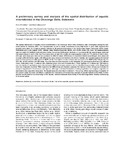| dc.identifier.citation | Dallas, H.F. & Mosepele, B. (2006) A preliminary survey and analysis of the spatial distribution of aquatic invertebrates in the Okavango Delta, Botswana, African Journal of Aquatic Science, Vol. 32, No. 1, pp. 1-11 | en_US |
| dc.description.abstract | The spatial distribution of aquatic macroinvertebrates in the Okavango River Delta, Botswana, was investigated during the low-water period in February 2003. This complements an earlier study undertaken during high-water in June 2000. Seventy-five samples were taken in a range of aquatic habitats at 29 georeference points in four focal areas: Upper Panhandle (UPH), Lower Panhandle and Guma Lagoon (LPH), Moremi Game Reserve/Xakanaka (MGR), and Chief’s Island (CI). Over 180 morphospecies (approximately 63 families) were recorded during the survey. Multivariate analyses of macroinvertebrate assemblages indicated that assemblages in each of the four focal areas were at least 54% similar at morphospecies level, and 71% similar at family level, although some taxa were more or less common in different areas. Differences in macroinvertebrate assemblages were observed amongst different habitat types, with differences most pronounced between the deltaic habitats and isolated seasonally-flooded pools and temporary rain-filled pools in MGR and CI. The highest number of taxa was recorded in the MGR (125), followed by the UPH (96), CI (93) and the LPH (89) areas. The most families were recorded in the Hemiptera (11), followed by Mollusca (10), Diptera (nine), Coleoptera (nine), Crustacea (six), Ephemeroptera (six) and Odonata (four). Three families of Hirudinea and Trichoptera, and one family of Lepidoptera, were also recorded. Hydracarina were common but not identified beyond order, while Oligochaeta were less frequently recorded. With respect to the different aquatic habitats sampled, the highest number of taxa was recorded in marginal vegetation in the channels and lagoons, although inundated floodplains, floating vegetation and marginal vegetation in backwaters also supported many taxa. The fewest taxa were recorded in sediment. This survey, whilst representing a ‘snapshot’ of the system under low-water conditions, highlights the importance of maintaining a mosaic of aquatic habitats in the Delta. Further studies would enhance our knowledge of the aquatic macroinvertebrate biodiversity of the Okavango Delta, thereby contributing to its conservation. | en_US |

